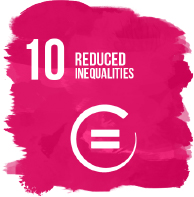Sustainable Development Goals 10: Reduced Inequalities
Reduce inequality
within and among
countries
Before the COVID19 pandemic, various indicators of inequality were moving in the correct direction. In certain nations, income disparity had decreased. Low-income nations benefited from privileged trade status for the second year in a row. The cost of remittance transactions was decreasing. Most nations with data have policies that made migration more orderly, safe, and responsible. However, inequality continues, whether in terms of income, wealth, opportunity, or other factors. Those who are deemed vulnerable are subjected to a variety of discriminatory practices. The pandemic is increasing existing disparities within and across countries, wreaking havoc on the most vulnerable individuals and countries. Reducing vulnerability to health and other catastrophes, as well as strengthening society's resilience, will require addressing inequality.
The COVID19 pandemic causes challenges to people who are refugees.
For refugees, the COVID19 pandemic has been extremely difficult. At the peak of the pandemic in 2020, 164 nations had closed their borders completely or partially, with 99 of them making no exceptions for persons seeking refuge, making these populations even more vulnerable. The number of individuals who had fled their nations and became refugees as a result of war, conflict, persecution, human rights violations, and events significantly breaking public order had risen to 24.5 million by the end of 2020, the largest absolute figure on record. 311 refugees live outside their nation of origin for every 100,000 individuals, more than double the amount in 2010. As an example, between 2010 and 2020, the number of refugees from Northern Africa and Western Asia grew from 579 to 1,562 per 100,000.

Comments
Post a Comment